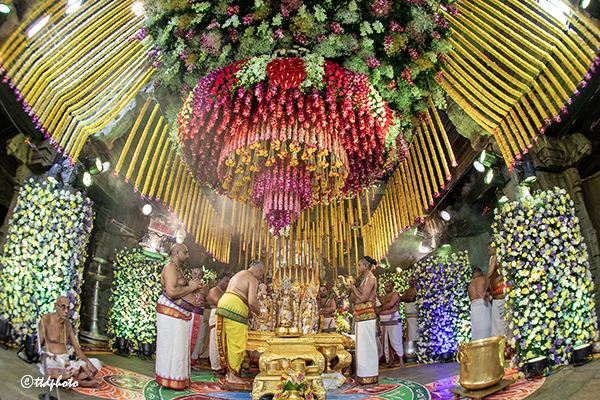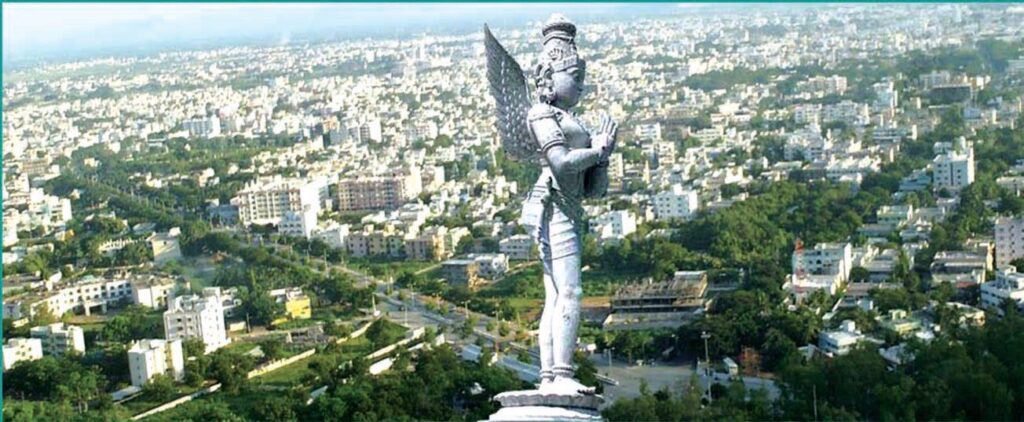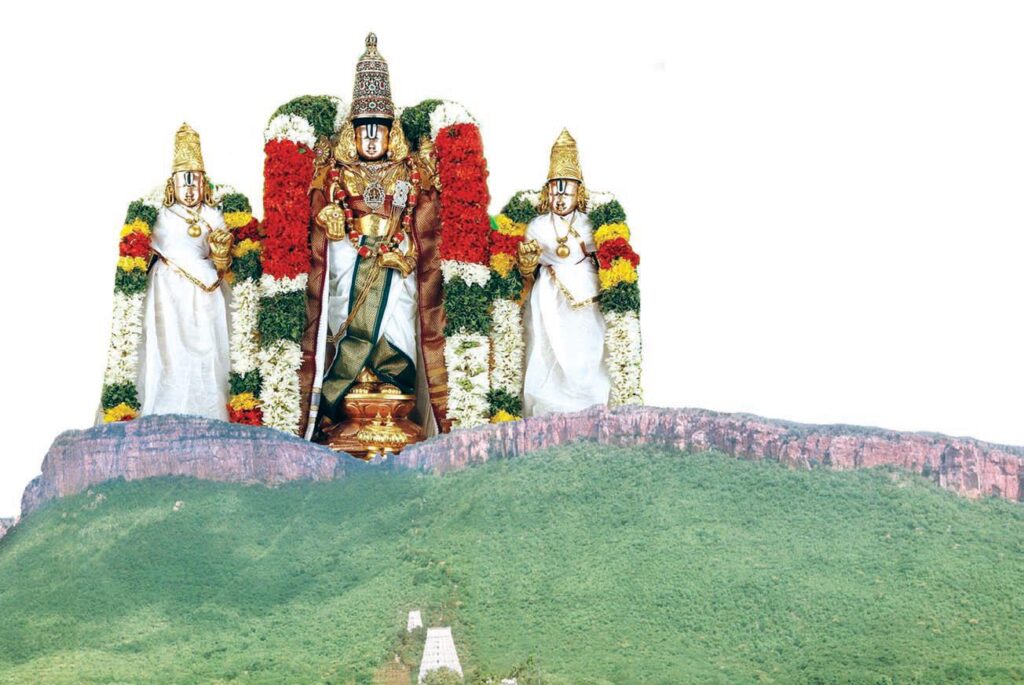Snapana Mandapam
As you enter through Golden doors you come across, not very much illuminated, a 27 feet quadrangular mandapam. This (Snapana Mandapam) has four pillars in the middle portion. Sculptured figures of Balakrishna, Yoga Narasimha, Sri Krishna Kaliya Mardhana, etc., can be seen on these pillars. It is known as “Tiruvilan Koil”, a Tamil word for Sanskrit Bala Aalayam.
Whenever repairs or renovation or reconstruction work of Sanctum Sanctorum, either inside or outside is taken up they will have a shift to temple Bala Aalayam. The potency (tejas) of the Lord will be induced or transferred into another idol.
Bhoga Srinivasa Murthy
In the year 614 A.D., it is said a Pallava queen by name ‘Samavayi’ (Perundevi) had offered a silver replica of Manvaala Perumal i.e., Bhoga Srinivasa Moorthy, to the temple. She oversaw the installation of the silver idol. Not only this, she made necessary arrangements to perform poojas as well as holy ablutions to Lord Venkateswara by granting necessary funds.
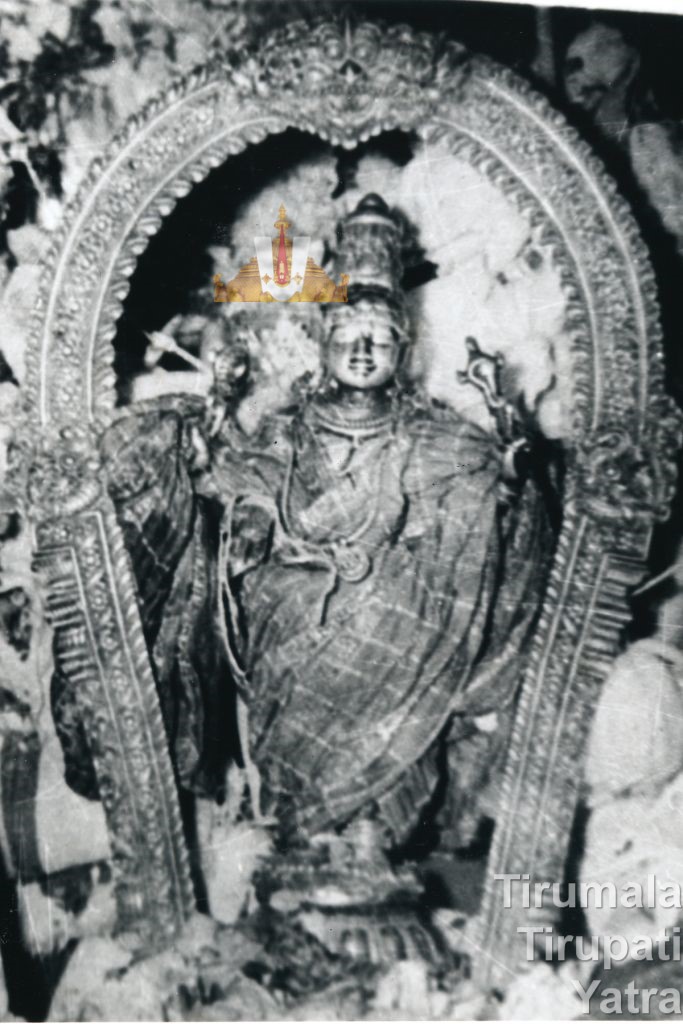
Researchers think that at the time of the installation of the Silver replica of Bhoga Srinivasa Moorthy, the priests would have made use of this Snapana Mandapam i.e., mandapam for holy ablutions.
Sri Bhandaram
In this Snapana Mandapam on both sides of the door, there are two rooms known as Sri Bhandaram. In the room to the right of the golden door they store the offerings collected from the “Hundi”. Everyday night after “Theermanam” (end of seva’s for the day) which follows Ekantha seva (service offered to the Lord in solitude), ‘Hundi’ is opened and then sealed firmly.
Well and firmly sealed Hundi then be taken to the “Bhandaram” (storehouse) which is to the north of Golden Door. Because of this, the rooms get the name of Kaanuka (gift or offering) Bhandaram.
Samarpanam
There is one more room to the south of the Golden Door. Here the costly jewelry of Lord Venkateswara is stored. The decoration of the Lord’s idol with costly precious jewelry is considered a special service. This service is known as ‘Samarpanam’.
There are three ways in which this samarpanam is carried out.
They are known as
- Sadaa (daily) samarpanam,
- Visesha (special) samarpanam and
- Mojaati (jewelry of historical importance) samarpanam.
All these expensive jewelry, precious stones, diamonds, etc. are stored in the store room which is to the south of the golden door.
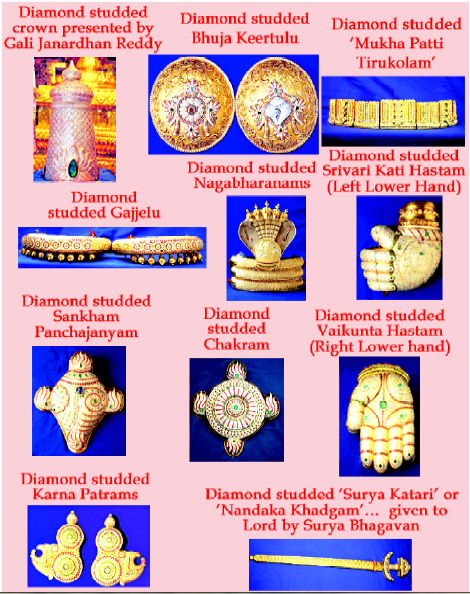
Sadaa (daily) samarpanam
Ornaments meant for daily adornment come under consideration for sada samarpanam. They include a Golden crown, a Golden hip hand (kati hastham), a blessing hand, a sword, an alligator-shaped necklace, and Lakshmi garlands, etc., These are ornaments made of gold. These will be in the custody of archakas i.e., purohits. These things adorn the Lord daily. They are valued at more than 1 crore.
Visesha Samarpanam
On special occasions, like the visit of the Prime Minister or President or any other dignitary, etc., and on important festival days very valuable things like a Diamond crown, diamond-studded Sankhu and Chakra, Vykuntta Hip Hands, etc., adorn the idol of Lord Venkateswara.
The aforesaid ornaments are studded with costly as well as very costly precious stones. These things will be under the custody of one special officer who is known as ‘Paarupattedaaru’. These things are worth more than two crores.
Mojaati Samarpanam
During Brahmothsavams, and other paid utsavas or special courts organized for Lord Venkateswara very old and precious ornaments of historical value donated by kings and emperors of bygone days (belonging to an earlier time.), as well as Kings and Zamindars of yester years adorn the Lord.
Being very valuable things they are kept safely in T.T.D.’s treasury. Before the Utsavams they will be taken from the treasury and will be returned after the Utsavams. Sada (Daily) Samarpanam ornaments or jewelry will be in the custody of priests. They keep these things in lockers of Samarpana mandiram.
Paarupattedaaru (A special officer in charge of the temple or a man in authority) will be overall in charge of the Lord’s Ornaments and Jewels.
Govinda! Govinda!! Govinda!!!
